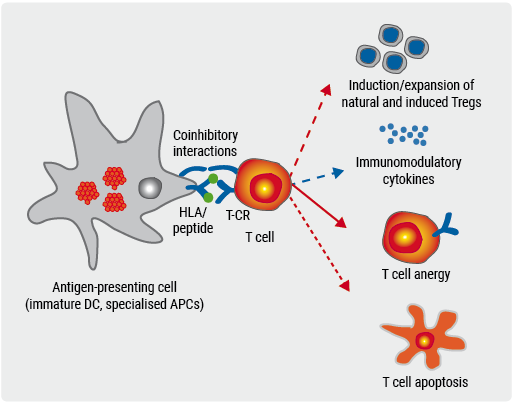Opicinumab is a human monoclonal antibody, blocking LINGO-1, a leucine-rich repeat protein. The SYNERGY trial (NCT01864148) –a previous opicinumab study– did not demonstrate a significant improvement of disability following opicinumab treatment, compared with placebo in patients with relapsing MS [2]. However, further analysis showed that a subgroup of patients, defined by disease duration, magnetisation transfer ratios, and diffusion tensor imaging-radial diffusion in pre-existing T2 lesions, may benefit from opicinumab. Therefore, the current phase 2 AFFINITY trial (NCT03222973) enrolled patients with similar imaging characteristics as those who showed a promising therapy response, to assess the efficacy and safety of opicinumab. The population was expanded with patients who did not have this favourable imaging profile. Patients were randomised to opicinumab (750 mg, intravenous, every 4 weeks; n=120) as add-on therapy, or placebo (n=120), next to background DMT. The primary endpoint was the Overall Disability Response Score (ODRS) at week 72. Prof. Peter Calabresi (Johns Hopkins University, MD, USA) presented the results.
ODRS scores did not demonstrate a statistical difference between patients receiving opicinumab (adjusted mean 0.11) and placebo (adjusted mean -0.04) at week 72 (difference 0.15; P=0.148). Similarly, the key secondary endpoint –confirmed disability improvement (CDI) at week 12– was not met. Prespecified subgroup analyses showed larger efficacy signals of opicinumab in patients >40 years, patients with EDSS scores ≥3, patients with a disease duration ≥6 years, and patients from the imaging core group. However, the EDSS score ≥3 subgroup was the only subgroup that demonstrated a significant benefit of opicinumab compared with placebo (ODRS difference 0.36; P=0.025). Patients who were on dimethyl fumarate as primary DMT showed numerically higher improvements of opicinumab compared with placebo (ODRS difference 0.31; P=0.105) than interferon beta users (ODRS difference 0.02), or natalizumab users (ODRS difference 0.13). Differences between imaging subgroups and DMT subgroups on pre-defined MRI endpoints were small and non-significant. The safety analysis did not reveal new safety issues of opicinumab and the results were consistent with the known safety profile of the drug.
Prof. Calabresi argued that, despite the non-significant results of the trial, further analyses of the AFFINITY and SYNERGY datasets regarding patient population and MRI biomarkers may help in the design of future trials aiming to enhance remyelination in patients with MS.
- Calabresi PA, et al. Efficacy and Safety of Opicinumab in Participants with Relapsing Multiple Sclerosis: A Randomized, Placebo-Controlled Phase 2 Trial (AFFINITY Part 1). OP147, ECTRIMS 2021 Virtual Congress, 13–15 October.
- Cadavid D, et al. Lancet Neurol. 2019;18(9):845–856.
Copyright ©2021 Medicom Medical Publishers
Posted on
Previous Article
« Elezanumab did not outperform placebo in progressive and relapsing MS Next Article
Evobrutinib reduces relapses and MRI lesion activity »
« Elezanumab did not outperform placebo in progressive and relapsing MS Next Article
Evobrutinib reduces relapses and MRI lesion activity »
Table of Contents: ECTRIMS 2021
Featured articles
Preliminary data shows positive results of ATA188 for progressive MS
COVID-19
MS patients at risk of hampered immune response after vaccination
Immunotherapy in MS does not influence COVID-19 severity and mortality
Anti-CD20 antibodies associated with worse COVID-19 outcomes
ECTRIMS-EAN consensus on vaccination in MS patients
Experimental Treatments
The role of astrocyte phenotypes in acute MS lesions
Promising results of intrathecal MSC-NTF cells in progressive MS
Preliminary data shows positive results of ATA188 for progressive MS
Evobrutinib reduces relapses and MRI lesion activity
Primary endpoint of opicinumab for relapsing MS not met in AFFINITY trial
Elezanumab did not outperform placebo in progressive and relapsing MS
Ibudilast reduced retinal atrophy in primary progressive MS
Treatment Trials and Strategies
ECTRIMS/EAN Clinical Guidelines on MS treatment: an update
Rituximab most effective initial MS therapy in Swedish real-world study
Ublituximab meets primary endpoint for relapsing MS
Dynamic scoring system aids decision to switch MS therapies early
Long-term suppression of MRI disease activity with ocrelizumab
Stopping DMT: when or if at all?
Biomarkers
Early predictors of disability progression in paediatric-onset MS
High-sensitive biomarker detection in MS via novel ELISA assay
Cortical lesions predict cognitive impairment 20 years after MS diagnosis
Applicability of sNfL measurement in clinical practice
MRI more sensitive for disease activity than relapses in SPMS
Imaging
Changes in GABA-receptor binding among cognitively impaired MS patients
T2 lesions independently predict early conversion to SPMS
Natural killer-like CD8+ T cells as a reservoir of clonal cells related to MS activity
Neuromyelitis Optica Spectrum Disorder (NMOSD)
Eculizumab, satralizumab, or inebilizumab for NMOSD?
Long-term efficacy of satralizumab for NMOSD
Long-term efficacy data: inebilizumab for NMOSD
Progressive MS
Charcot Award 2021: Progressive MS, a personal perspective
Top score poster: Meta-analysis on the effect of DMTs
Cortical lesions predict disease progression and disability accumulation
Ocrelizumab shows long-term benefits in primary progressive MS
Other
WNT9B-gene variant associated with doubled relapse risk in MS
Melatonin associated with improved sleep quality in MS patients
“Expanded Disability Status Scale 0 is not normal”
Personality trait alterations in MS patients
Related Articles
November 18, 2024
Frexalimab shows favourable safety and efficacy in OLE
January 7, 2021
Distinct cognitive phenotypes in multiple sclerosis proposed

November 8, 2019
Late-breaking: Myelin-peptide coupled red blood cells
© 2024 Medicom Medical Publishers. All rights reserved. Terms and Conditions | Privacy Policy
HEAD OFFICE
Laarderhoogtweg 25
1101 EB Amsterdam
The Netherlands
T: +31 85 4012 560
E: publishers@medicom-publishers.com

